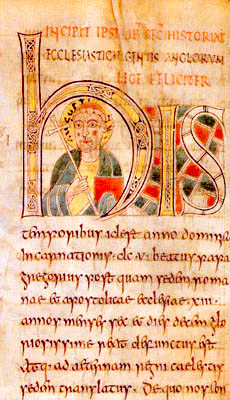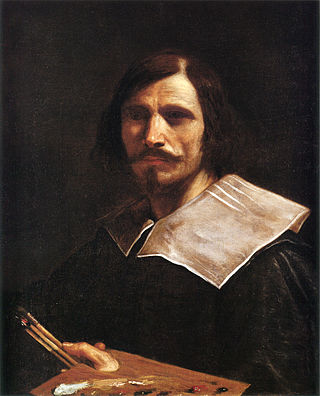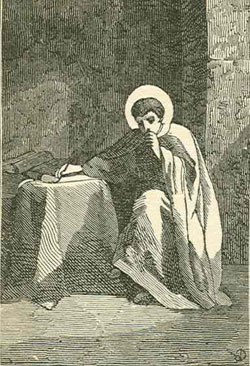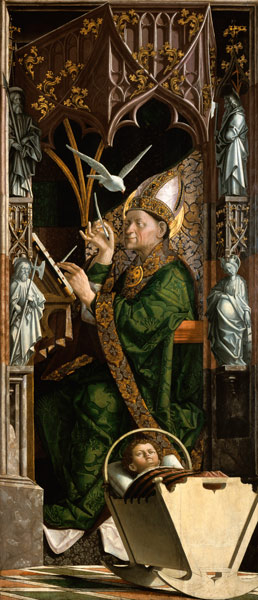
Augustine of Hippo, also known as Saint Augustine, was a theologian and philosopher of Berber origin and the bishop of Hippo Regius in Numidia, Roman North Africa. His writings influenced the development of Western philosophy and Western Christianity, and he is viewed as one of the most important Church Fathers of the Latin Church in the Patristic Period. His many important works include The City of God, On Christian Doctrine, and Confessions.

Augustine of Canterbury was a Christian monk who became the first archbishop of Canterbury in the year 597. He is considered the "Apostle to the English”.

Pope Boniface I was the bishop of Rome from 28 December 418 to his death on 4 September 422. His election was disputed by the supporters of Eulalius until the dispute was settled by Emperor Honorius. Boniface was active in maintaining church discipline, and he restored certain privileges to the metropolitical sees of Narbonne and Vienne, exempting them from any subjection to the primacy of Arles. He was a contemporary of Augustine of Hippo, who dedicated to him some of his works.

Pope Siricius was the bishop of Rome from December 384 to his death. In response to inquiries from Bishop Himerius of Tarragona, Siricius issued the Directa decretal, containing decrees of baptism, church discipline and other matters. His are the oldest completely preserved papal decretals. He is sometimes said to have been the first bishop of Rome to call himself pope.

Pope Gregory I, commonly known as Saint Gregory the Great, was the 64th Bishop of Rome from 3 September 590 to his death. He is known for instituting the first recorded large-scale mission from Rome, the Gregorian mission, to convert the then largely pagan Anglo-Saxons to Christianity. Gregory is also well known for his writings, which were more prolific than those of any of his predecessors as pope. The epithet Saint Gregory the Dialogist has been attached to him in Eastern Christianity because of his Dialogues. English translations of Eastern texts sometimes list him as Gregory "Dialogos" from the Greek διάλογος, or the Anglo-Latinate equivalent "Dialogus".

Pope Soter was the bishop of Rome from c. 167 to his death in c. 174. According to the Annuario Pontificio, the dates may have ranged from 162–168 to 170–177. He was born in Fondi, Campania, today in the Lazio region of Italy. Soter is known for declaring that marriage was valid only as a sacrament blessed by a priest and also for formally inaugurating Easter as an annual festival in Rome. His name, from Greek Σωτήριος from σωτήρ "saviour", would be his baptismal name, as his lifetime predates the tradition of adopting papal names.

Augustinians are members of several religious orders that follow the Rule of Saint Augustine, written in about 400 AD by Augustine of Hippo. There are two distinct types of Augustinians in Catholic religious orders dating back to the 12th–13th centuries:

Giovanni Francesco Barbieri, better known as (il) Guercino, was an Italian Baroque painter and draftsman from Cento in the Emilia region, who was active in Rome and Bologna. The vigorous naturalism of his early manner contrasts with the classical equilibrium of his later works. His many drawings are noted for their luminosity and lively style.

Prosper of Aquitaine, also called Prosper Tiro, was a Christian writer and disciple of Augustine of Hippo, and the first continuator of Jerome's Universal Chronicle.

Giles of Rome O.S.A. was a medieval philosopher and Scholastic theologian and a friar of the Order of St Augustine, who was also appointed to the positions of prior general of his order and as Archbishop of Bourges. He is famed as being a logician, who produced a commentary on the Organon by Aristotle, and as the author of two important works: De ecclesiastica potestate, a major text of early-14th-century papalism, and De regimine principum, a guide book for Christian temporal leadership. Giles was styled Doctor Fundatissimus by Pope Benedict XIV.

Bruno of Cologne, venerated as Saint Bruno, was the founder of the Carthusian Order. He personally founded the order's first two communities. He was a celebrated teacher at Reims, and a close advisor of his former pupil, Pope Urban II. His feast day is 6 October.

In religious studies, homiletics is the application of the general principles of rhetoric to the specific art of public preaching. One who practices or studies homiletics may be called a homilist, or more simply, a preacher.
The Canons Regular of St. Augustine are priests who live in community under a rule and are generally organised into religious orders, differing from both secular canons and other forms of religious life, such as clerics regular, designated by a partly similar terminology. As religious communities, they have laybrothers as part of the community.

Michael Pacher was a painter and sculptor from Tyrol active during the second half of the fifteenth century. He was one of the earliest artists to introduce the principles of Renaissance painting into Germany. Pacher was a comprehensive artist with a broad range of sculpting, painting, and architecture skills producing works of complex wood and stone. He painted structures for altarpieces on a scale unparalleled in North European art.

Raffaele Sansoni Galeoti Riario was an Italian cardinal of the Renaissance, mainly known as the constructor of the Palazzo della Cancelleria and the person who invited Michelangelo to Rome. He was a patron of the arts. He was also the first adolescent to be elevated in the College of Cardinals in the history of the Holy See.

The Order of Discalced Augustinians is a mendicant order that branched off from the Order of Saint Augustine as a reform movement.

The Disputation of the Sacrament, or Disputa, is a painting by the Italian Renaissance artist Raphael. It was painted between 1509 and 1510 as the first part of Raphael's commission to decorate with frescoes the rooms that are now known as the Stanze di Raffaello, in the Apostolic Palace in the Vatican. At the time, this room was known as the Stanza della Segnatura, and was the private papal library where the supreme papal tribunal met.
The Brothers of Penitence or Friars of the Sack were an Augustinian community also known as Boni Homines or Bonshommes, with houses in Spain, France and England.
Catholic dogmatic theology can be defined as "a special branch of theology, the object of which is to present a scientific and connected view of the accepted doctrines of the Christian faith."

The Baptism of Christ is a fresco by the Italian Renaissance painter Pietro Perugino and his workshop, executed around 1482 and located in the Sistine Chapel, Rome.

















